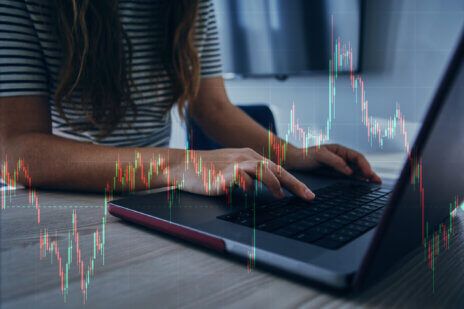
2025 has been full of surprises all over the world, which makes our thoughts at the beginning of the year, including opportunities and risks outside of the U.S. compared to the U.S., relative value opportunities across the globe, and AI’s capital intensity, that much more relevant.
Liberation Day Volatility Spike
Volatility spiked in April, following the “Liberation Day” announcements from the Trump administration. Although this surge in volatility did not quite reach the levels seen when Russia invaded Ukraine, let alone the levels of COVID, the 2011-2012 U.S. debt ceiling stand-off, European debt crisis, or the financial crisis. The market action may have felt disorienting, but it was only moderately worse than many other historical scares and not as bad as prior “big ones.”
Equity Indices’ Rolling 90-Day Volatility
Source: Bloomberg
How Have Earnings Reacted?
While volatility in price action was substantial, expectations for corporate fundamentals have actually been fairly steady. Through the end of June, consensus earnings estimates for major equity indices (also indicative of the health of corporate borrowers) are stable to down mid-single digits. Valuations have also barely budged, indicating investors’ comfort with the growth outlook as well.
The following compares consensus expectations exiting June 2025 with expectations from two points in time: a month before last year’s U.S. election, and just before Donald Trump was sworn in as President.
Source: Bloomberg
A notable takeaway is that, when thinking about prospective new tariff policies, investors have generally been more concerned about U.S. earnings power than a tariff squeeze on the rest of the world. Questions and concerns about the earnings outlook led U.S. equity markets to fall more after Liberation Day, and even in dollar terms, as other developed equity markets have been outpacing the U.S. both before and after tariff announcements.
Source: Bloomberg
The Balance of U.S. vs. non-U.S. Equities
Global investors have been overallocated to the U.S. for a number of years, and foreign flows have helped support the U.S.’ persistent valuation rerating over the last decade. But in a world of U.S. tariffs, investors are taking note of a different characteristic of non-U.S. companies; foreign businesses actually have limited dependence on the U.S.
We have entered a world where U.S. corporates’ supply chains and U.S. consumers’ spending power are being impacted more broadly and directly by U.S. tariffs compared to companies and consumers outside the U.S. This may mean that there is a higher predictability of foreign company earnings because a lower share of their business is tied to the U.S.
Source: Bloomberg
Investor sentiment is key to maintaining the substantial differential in valuations between the U.S. and the rest of the world. There is less certainty about “U.S. Exceptionalism” today than during the euphoric U.S. market environment late last year for the following reasons:
- The U.S. is about 26% of global GDP, but 64% of the global market cap.
- However, the U.S. accounts for approximately 54% of global earnings, mostly due to the higher profitability of the U.S. tech sector.
- Keep in mind that the statistics above are proportions of the total. Explained in another way, the rest of the world’s GDP is three times bigger than the U.S. (3/4 vs. 1/4), but the U.S.’ market cap is about twice the size of the rest of the world (2/3 vs. 1/3), as earnings are nearly the same.
Therefore, the main reason the U.S. market cap is so much bigger is simply valuation. Aggregate U.S. earnings are about 15% larger than the rest of the world. It trades at a 50%-plus valuation premium to the rest of the world, or a 25%-plus premium if equal-weighting all companies to reduce the Mag 7’s impact on the U.S.
Source: Bloomberg
What we aren’t declaring is that U.S. valuations are poised to collapse or that investors in U.S. equities are being senseless. But we are observing that from a relative value perspective, there are high-quality foreign companies with good outlooks that trade at lower valuations than their U.S. peers. The first half of 2025 has shown that as politics complicated the U.S. outlook, U.S.-based and non-U.S. investors have been comfortable shifting capital out of the U.S. and into global markets.
Could the mammoth inflows that have benefited U.S. valuations be reversing?
Source: Bloomberg
We’re Still Talking About AI
It’s still too early to tell if there was a paradigm shift in the artificial intelligence (AI) outlook in January when the Chinese company DeepSeek announced a new AI model that was clearly competitive with the top models in the U.S. However, beyond how “good” the model was, the real paradigm shift may have been focused on cost. DeepSeek created a design for building, training, and operating the model that has lower operating costs and requires lower capital expenditures (perhaps also less dependent on bleeding-edge chips.
This dynamic certainly matters for the Mag 7, and perhaps for the broader U.S. market. Big Tech’s huge cash flow has supported the optics of, on average, solid U.S. corporate balance sheet health for many years. Big tech previously had low capital intensity, which supported big net cash balances and excess cash flow, creating the potential for buybacks and dividends. But since OpenAI first changed the world’s perspective about how advanced generative AI has become, Big Tech has notably increased its capital expenditures on data centers and advanced GPU chips.
Quarterly Capital Expenditures Relative to Cash Flow
Source: Bloomberg
Whether DeepSeek is a long-term winner is less relevant than the way it opened the world’s eyes to the fact that competitive advantage in AI may no longer be the same as was previously expected. Silicon Valley has been the clear leader of the global technology industry for decades, and it was expected to sustain this leadership with AI. But for non-US companies pursuing AI solutions or innovation, DeepSeek demonstrated that the barriers to entry are lower than previously believed.
The future “Masters of AI” are now more likely to be global, rather than only sitting in the Western United States. This may change the valuations applied to US tech leaders, or it may lead shareholders (or management teams) to question their allocation of capital and whether they should dial back on AI investments.
There is a complicated balance for identifying where value lays, and where investment opportunities offer asymmetric return potential. Among considerations for earning an appropriate real return:
- U.S. Equities: There is low compensation from the dividends, so confidence in both the duration of earnings growth and a low equity risk premium (supporting elevated valuations) is required.
- International Equities: Dividend yields are higher than in U.S. equities, but not competitive with yields in the bond market today. However, the potential earnings growth has improved, and there is an opportunity from valuation or a further strength in non-currencies.
Final Thoughts
All in, there’s no “easy trade” today. But the U.S. environment is at a trickier point, relative to the rest of the world, than it has been in quite some time. This makes it easier for equity investors to consider reducing their U.S. allocations to diversify into other geographies. Moreover, foreigners now own close to 20% of the US equity market. It’s not just whether Americans want to invest more internationally, but the relative value outside the U.S. may also attract global investors and could trim U.S. holdings to fund new investments in other markets.
Discover more about:
More Insights

Thornburg Income Builder Opportunities Trust Announces Distribution

Ferrari’s Electric Future and the Evolution of Luxury Investing

FOMC Update: Fed Approves Third Consecutive Rate Cut, Projects Slower Pace

Luxury Brands Navigate China Slowdown and Tariff Pressures

Thornburg Investment Income Builder Fund – 4th Quarter Update 2025


